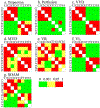On the Relationship between Dynamic Contrast-Enhanced Ultrasound Parameters and the Underlying Vascular Architecture Extracted from Acoustic Angiography
- PMID: 30509785
- PMCID: PMC6352898
- DOI: 10.1016/j.ultrasmedbio.2018.08.018
On the Relationship between Dynamic Contrast-Enhanced Ultrasound Parameters and the Underlying Vascular Architecture Extracted from Acoustic Angiography
Abstract
Dynamic contrast-enhanced ultrasound (DCE-US) has been proposed as a powerful tool for cancer diagnosis by estimation of perfusion and dispersion parameters reflecting angiogenic vascular changes. This work was aimed at identifying which vascular features are reflected by the estimated perfusion and dispersion parameters through comparison with acoustic angiography (AA). AA is a high-resolution technique that allows quantification of vascular morphology. Three-dimensional AA and 2-D DCE-US bolus acquisitions were used to monitor the growth of fibrosarcoma tumors in nine rats. AA-derived vascular properties were analyzed along with DCE-US perfusion and dispersion to investigate the differences between tumor and control and their evolution in time. AA-derived microvascular density and DCE-US perfusion exhibited good agreement, confirmed by their spatial distributions. No vascular feature was correlated with dispersion. Yet, dispersion provided better cancer classification than perfusion. We therefore hypothesize that dispersion characterizes vessels that are smaller than those visible with AA.
Keywords: Acoustic angiography; Cancer; Dispersion; Dynamic contrast-enhanced ultrasound; Perfusion; Ultrasound contrast agents.
Copyright © 2018 Elsevier Ltd. All rights reserved.
Figures






Similar articles
-
Visualization of Microvascular Angiogenesis Using Dual-Frequency Contrast-Enhanced Acoustic Angiography: A Review.Ultrasound Med Biol. 2020 Oct;46(10):2625-2635. doi: 10.1016/j.ultrasmedbio.2020.06.009. Epub 2020 Jul 20. Ultrasound Med Biol. 2020. PMID: 32703659 Free PMC article. Review.
-
Assessment of angiogenesis in rabbit orthotropic liver tumors using three-dimensional dynamic contrast-enhanced ultrasound compared with two-dimensional DCE-US.Jpn J Radiol. 2019 Oct;37(10):701-709. doi: 10.1007/s11604-019-00861-z. Epub 2019 Aug 10. Jpn J Radiol. 2019. PMID: 31401722
-
Optimizing Sensitivity of Ultrasound Contrast-Enhanced Super-Resolution Imaging by Tailoring Size Distribution of Microbubble Contrast Agent.Ultrasound Med Biol. 2017 Oct;43(10):2488-2493. doi: 10.1016/j.ultrasmedbio.2017.05.014. Epub 2017 Jun 28. Ultrasound Med Biol. 2017. PMID: 28668636 Free PMC article.
-
Fractal Dimension of Tumor Microvasculature by DCE-US: Preliminary Study in Mice.Ultrasound Med Biol. 2016 Dec;42(12):2852-2863. doi: 10.1016/j.ultrasmedbio.2016.08.001. Epub 2016 Sep 2. Ultrasound Med Biol. 2016. PMID: 27592557
-
Dynamic contrast-enhanced ultrasound for quantification of tissue perfusion.J Ultrasound Med. 2015 Feb;34(2):179-96. doi: 10.7863/ultra.34.2.179. J Ultrasound Med. 2015. PMID: 25614391 Review.
Cited by
-
Three-dimensional visualization and improved quantification with super-resolution ultrasound imaging - validation framework for analysis of microvascular morphology using a chicken embryo model.Phys Med Biol. 2021 Apr 16;66(8):10.1088/1361-6560/abf203. doi: 10.1088/1361-6560/abf203. Phys Med Biol. 2021. PMID: 33765676 Free PMC article.
-
Spatial heterogeneity of nanomedicine investigated by multiscale imaging of the drug, the nanoparticle and the tumour environment.Theranostics. 2020 Jan 1;10(4):1884-1909. doi: 10.7150/thno.38625. eCollection 2020. Theranostics. 2020. PMID: 32042343 Free PMC article. Review.
-
B-Mode and Doppler Ultrasonography in a Murine Model of Ehrlich Solid Carcinoma With Different Growth Patterns.Front Oncol. 2020 Nov 4;10:560413. doi: 10.3389/fonc.2020.560413. eCollection 2020. Front Oncol. 2020. PMID: 33251133 Free PMC article.
-
Visualization of Microvascular Angiogenesis Using Dual-Frequency Contrast-Enhanced Acoustic Angiography: A Review.Ultrasound Med Biol. 2020 Oct;46(10):2625-2635. doi: 10.1016/j.ultrasmedbio.2020.06.009. Epub 2020 Jul 20. Ultrasound Med Biol. 2020. PMID: 32703659 Free PMC article. Review.
-
Acoustic Angiography: Superharmonic Contrast-Enhanced Ultrasound Imaging for Noninvasive Visualization of Microvasculature.Methods Mol Biol. 2022;2393:641-655. doi: 10.1007/978-1-0716-1803-5_34. Methods Mol Biol. 2022. PMID: 34837204
References
-
- Brock M, Eggert T, Rein JP, Roghmann F, Braun K, Bjrn L, Sommerer F, J. N, Bodman C. Multiparametric ultrasound of the prostate: Adding contrast enhanced ultrasound to real-time elastography to detect histopathologically confirmed cancer. J Urol, 2013;189:93–98. - PubMed
-
- Cosgrove D, Lassau N. Imaging of perfusion using ultrasound. Eur J Nucl Med Mol Imaging, 2010;37:65–85. - PubMed
-
- Cox B, Beard P. Super-resolution ultrasound. Nature, 2015;527:451–452. - PubMed
-
- Errico C, Pierre J, Pezet S, Desailly Y, Lenkei Z, Couture O, M. T. Ultra fast ultrasound localization microscopy for deep super-resolution vascular imaging. Nature, 2015;527:499–502. - PubMed
Publication types
MeSH terms
Substances
Grants and funding
LinkOut - more resources
Full Text Sources

